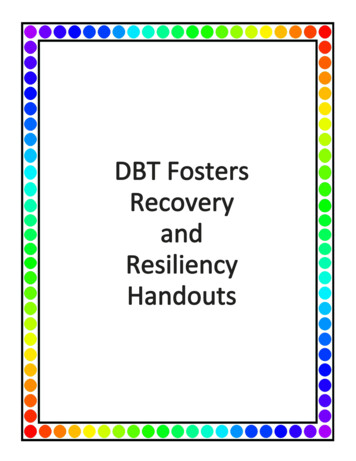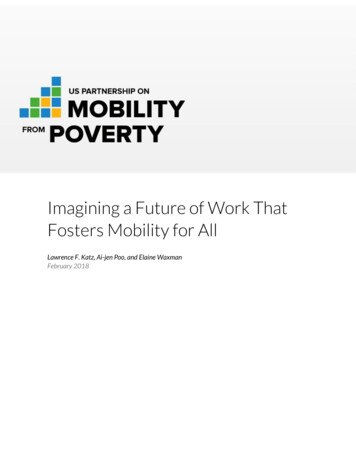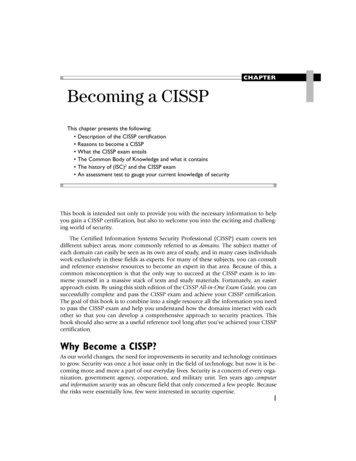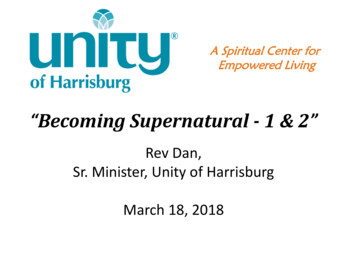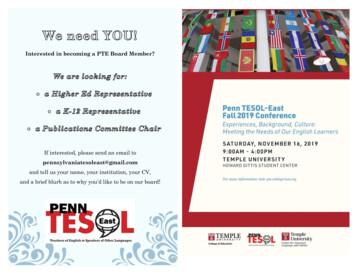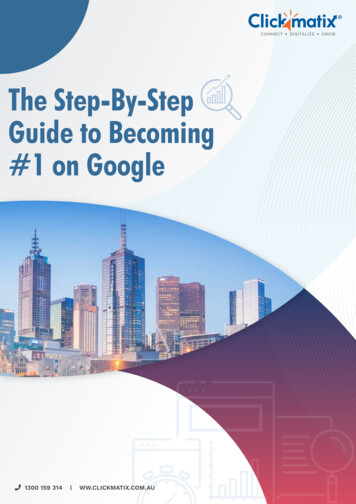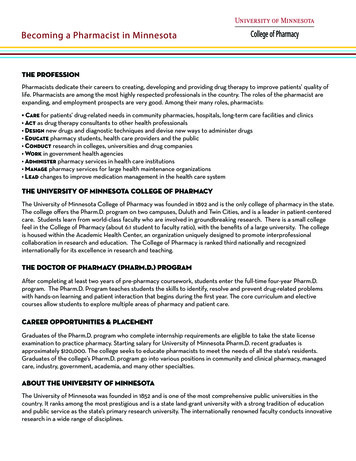
Transcription
WHITE PAPERBecoming a Leader Who Fosters InnovationBy: David Magellan Horthand Jonathan Vehar
ContentsIntroduction2Business Thinking vs. Innovation Thinking4Becoming More Innovative: It’s Not as Simple as It Seems6Myth: Individual Creativity Can Be Mandated and Managed.6Myth: Simply Unleashing Creative Talent Can Help You Navigate Complexity.7Beyond the “Innovation Silo”8Building Blocks for Innovation Leadership10Effective Innovative Thinking requires all three . . .11Innovation Leadership Toolset12Innovation Leadership Skillset14Innovation Leadership Mindset16Bringing Focus to Innovation Leadership18What KEYS to Creativity and Innovation Measures19Tips for Developing a More Innovative Organization21A Call-to-Action for the Innovation Leader22References24About the Authors251
IntroductionNot long ago we spoke to a senior leader in alarge multinational organization who voiced hisfrustration about the lack of innovation in hisbusiness—even after a year-long campaign toturn things around. By the time solutions filteredup the hierarchy to him, they were “totally derisked” and lacked creativity. The culture of theorganization led managers to strip away any innovation found in new ideas—rendering solutionsthat were weak, limited in scope, and impotent.The executive said he wanted to create a cultureof innovation that would allow ideas to grow andflourish, add value, and help the organizationachieve its growth targets.He’s not alone in his concerns, as evidenced byhow hot a topic innovation is today. But thatwasn’t always the case. At one time, strategy wasking. Forecasting, planning, and placing smartbets created the power sources within organizations. The future of a business (or a career)followed an established framework. If leadersmanaged well, success would follow.Today, complexity and uncertainty are palpable.Planning for even the next quarter is a challenge.Even more difficult is committing to decisionsthat will play out over one to five years. In thewords of one senior executive: “We’ve lost ourcrystal ball.” What is the next breakthrough product, game-changing service, or compelling vision?What’s the process for getting there?2 2014 Center for Creative Leadership. All rights reserved.Even in more stable times, strategy execution often fails because companies neglect to take intoaccount the inevitable inertia within the organization best represented by the slogan, “Culture EatsStrategy for Breakfast.” An analysis of severalstudies correlating organizational performancewith culture using the Denison OrganizationalSurvey found that “culture . . . is an importantpredictor of organizational performance.” (Discovery Learning, 2007)Innovation involves implementingsomething new that adds value orquantifiable gain. It requires manyskillsets, usually those of a team.It should be no surprise that in these uncertaintimes, innovation is the buzzword du jour (again)and remains critical to an organization’s top andbottom line. Without new sources of value—whether that’s defined in terms of quantity ofrevenue or quality of life—most organizationseventually wither and die. The world around themchanges and competitors emerge to provide thesame offerings more effectively or efficiently.Research by Soo et al. (2002) concluded, “Thegreater the amount of innovation, the greater the
market and financial performance.” A recent studyby Capgemini (2012) comes to the same conclusionand identifies the critical organizational innovationelements that differentiate leaders from laggards,including an explicit innovation strategy, innovationgovernance, and more.So it makes sense that a 2007 BCG survey revealedthat 66% of the 2,468 execs surveyed ranked innovation among the top three strategic priorities fortheir companies (Sirkin et al., 2007). Even after therecession, an IBM Global CEO Study (2010) showsCEOs of organizations thriving during the prevailing economic turbulence believe that creativity hasbeen fundamental to their success—and will continue to be into an even more uncertain and complex future. A related IBM global report involvingChief HR Officers (2010) further suggests that whileorganizations know how to develop strong business managers, they have been largely ineffective atdeveloping creative leaders.It’s as if there has been a conspiracy at many levelsof our culture to stifle the creative disciplines inbusiness. When the Center for Creative Leadership(CCL ) researched the leadership competenciesneeded to navigate complexity, they encounteredseveral C-suite executives who had well-developedartistic talents. Even at their level in the organization, though, they seemed powerless to buck theprevailing culture and use their creative competencies to address challenges and opportunities.Instead they deliberately tried to separate theircreative self from their business self (Palus andHorth, 2002).The same dynamic can play out even when an organization thinks it wants innovation. Most organizations that embark on an innovation campaign areout to find breakthroughs or “disruptive” innovations that represent a new way of doing things.Rarely do these innovations emerge, though. And ifthey do, they almost never make it to the marketplace. That’s because the organization inevitablychokes on the radical nature of the offering, whichdoesn’t fit into its current reality.Actively pursuing innovation requires considerableresources and deliberate focus. It requires innovation leadership, support from the organizationalhierarchy, and a culture that values and nurturescreativity. 2014 Center for Creative Leadership. All rights reserved.3
Business Thinking vs. Innovation ThinkingThe development of effective creative leadershipis a two-step process. First, leaders individuallyand collectively must get in touch with their owncreative thinking skills in order to make sense ofand deal with complexity. Second, rather thandevelop skills for the “management of creativity”(a control mindset), organizations must developa creative leadership culture—a climate thatpromotes and acknowledges the creative process.Authors and researchers Teresa Amabile (2010)and Goran Ekvall (1999) speak authoritativelyand elegantly on this topic. Amabile talks about“Management for Creativity.” Ekvall in severalpublications describes the statistical significanceof leadership in creating (or not!) an environmentthat nurtures creativity.A creative leadership culture recognizes andskillfully manages the tensions between severalinterrelated and seemingly polar opposites. Majoramong these is the tension between traditionalbusiness thinking and innovative thinking.Today’s managers are typically skilled practitioners of traditional business thinking with itsdeep research, formulas, and logical facts. Business thinkers are often quick to make decisions,sorting out the right answer from among wronganswers. Deductive and inductive reasoning arefavored tools as they look for proof or precedentto inform decisions. Business thinking is aboutremoving ambiguity and driving results.But ambiguity cannot be managed away. Drivingresults is impossible when the situation is unstable, the challenge is complex, the direction isunclear, or when you’re mapping new territory, asis the case—by definition—with innovation.Many of today’s leadership problems are criticaland pressing, and they demand quick and decisiveaction. But at the same time, they are so complexwe can’t just dive in. We need to slow down, reflect, and approach the situation in an unconventional way using innovative thinking.BUSINESS THINKING vs. INNOVATION THINKINGLogicalDeductive/Inductive reasoningRequires proof to proceedLooks for precedentsQuick to decideThere is right and wrongUncomfortable with ambiguityWants results4 2014 Center for Creative Leadership. All rights reserved.IntuitiveAbductive reasoningAsks what if?Unconstrained by the pastHolds multiple possibilitiesThere is always a better wayRelishes ambiguityWants meaning
Unlike business thinking, innovative thinking doesn’t rely onpast experience or known facts. It imagines a desired futurestate and how to get there. It is intuitive and open to possibility. Rather than identifying right answers or wrong answers,the goal is to find a better way and to explore multiple possibilities. Ambiguity is an advantage, not a problem. It allowsus to ask “what if?”Innovative thinking is a crucial addition to traditional business thinking. It allows you to bring new ideas and energy toyour role as leader and paves the way to bring more innovation into your organization.We want to emphasize that there is a critical leadership skillinvolved in managing the tension between these two seeming opposites. It is not about discarding the business thinking.It’s about acknowledging that both exist and that productive new products and services will result from finding thedelicate balance between the two approaches. It’s also aboutthe ability to switch between these two modes of thinking inorder to implement creative ideas and turn them into innovations. Leaders and organizations that do so will find a powerful antidote to complexity and an engine that can help themthrive—even during uncertain times.Key DefinitionsLeadershipA process by which an individual or group creates direction,alignment, and commitment fortheir shared work.Innovation LeadershipA process for creating direction,alignment, and commitmentneeded to create and implement something new thatadds value. 2014 Center for Creative Leadership. All rights reserved.5
Becoming More Innovative:It’s Not as Simple as It SeemsMany articles gloss over what it takes to become more innovative. It’s as if the writers believe creativity will beunleashed with a snap of the finger to facilitate a competitive advantage. But it’s not that simple.MYTH: Individual Creativity CanBe Mandated and Managed.A dear colleague at CCL, Dave Hills, drew a lovely cartoonto illustrate the myth of the mandate. It shows a seniorexecutive—presumably returning from the latest seminaron organizational innovation—demanding creativity froma group of bound and gagged people.Managers can’t mandate innovation. They do, though,need to lead it and “walk the talk.” Too many times we seeleaders make pronouncements of, “we need innovation!”and then proceed to quash new ideas. They often do sounconsciously through lack of knowledge about how eventhe smallest behaviors impede or encourage the creativityof others. We hope to address some of the more criticallyimportant behaviors in this paper.Integrity in supporting what you say the organizationneeds to do requires the extra work (and it is work) to fullyunderstand, consider, and evaluate innovative conceptsthat emerge and provide learning-oriented feedback.Without follow-through and role-modeling, the leader mayprovide direction, but create impediments to commitmentby failing to engage the intrinsic motivation, energy, andpassion of those led.Leaders can contribute to alignment by taking an activerole in creating systems that enable the work of innovation to be coordinated effectively. With only proclaimeddirection (which is not necessarily shared), the leader isall talk, there is no incentive for others in the organization to share in the direction or do what they are askedto do—nor are there systems to facilitate the trajectory ofinnovations.While modeling innovation at the top is useful and necessary, it’s only the starting point. Time and again we’ve satin presentations where the “innovation expert” fires upthe crowd by telling them innovation can’t happen without senior management support. The message: All it takesfor innovation to take root in the organization is for seniormanagement to hoist the innovation flag. In practice, thistypically looks like simply hosting a big kick-off event.Sometimes it is even followed by rolling training throughthe organization as quickly as possible, starting at the topand working down.Reflecting on what we’ve seen work, we’ve come to theconclusion that the opposite is a better strategy. Ratherthan a “push” mentality, we suggest leveraging seniormanagement sponsorship and working in small groups todevelop the tools, skills, and mindset necessary to driveinnovation. Then let the results speak for themselves—creating a hunger and a “pull” in the organization for moreinnovation development.6 2014 Center for Creative Leadership. All rights reserved.
MYTH: Simply Supporting Creative TalentCan Help You Navigate Complexity.When considering how to make your organization more innovative, you might be tempted todiscover and support creative heroes and to trainothers to be just like them. Our colleagues JohnMcGuire and Gary Rhodes (2009) in their bookTransforming Your Leadership Culture describe thisas an “independent” culture where heroes are valued and bold, independent action is highly prized,and the prevailing philosophy is that it’s better toask for forgiveness than permission.Imagine a company, though, where every big ideais pursued, regardless of how crazy or impractical.We know of at least one highly creative organization with a culture like this that continually burnsout talented managers who try to get a handleon the madness. Without appropriate structure,this kind of hero-driven, independent culture isa recipe for more complexity, not less, and in theworst case, anarchy.At the end of the day, it’s execution of the creative ideas that pays the bills. We also know fromthe research of people like Dr. Michael J. Kirton(2003) that those who prefer to challenge thestatus quo and generate radical ideas are typically not skilled at execution and implementation.They tend to be averse to structure or completelyignore it. Implementation is the skill of those attuned to shaping ideas, navigating organizationalsystems and structures, and transforming ideasinto useful processes, products, and services.When we interviewed Dr. Michael Lombardo, author, entrepreneur, and founder of Lominger Inc.,he talked a
their companies (Sirkin et al., 2007). Even after the recession, an IBM Global CEO Study (2010) shows CEOs of organizations thriving during the prevail-ing economic turbulence believe that creativity has been fundamental to their success—and will con-tinue to be into an even more uncertain and com- plex future. A related IBM global report involving Chief HR Officers (2010) further suggests .
